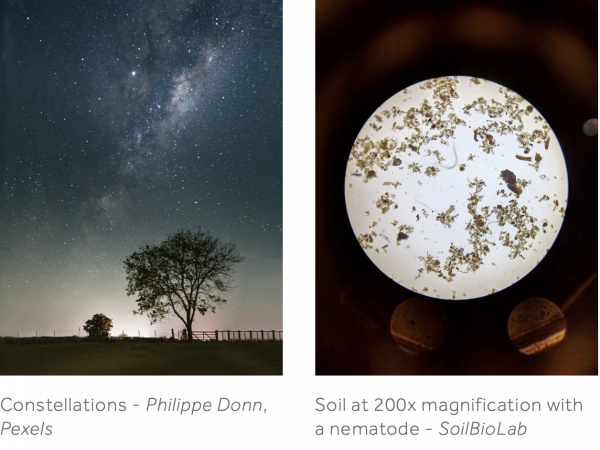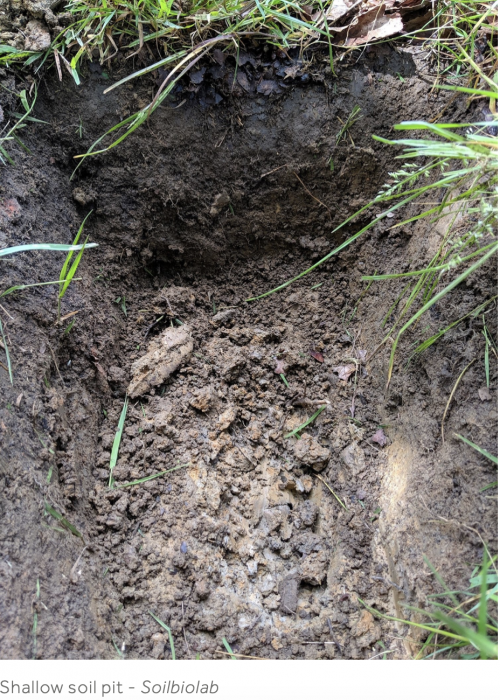The Mind-Blowing Parity of Soil and Space

Simon spends most days working from and coordinating soil samples and testing at SoilBioLab. For more information on how to test your soil, email
"We know more about the movement of celestial bodies than about the soil underfoot"
— Leonardo da Vinci
When you look up at the night sky, what do you see?
Thousands upon millions of stars.
When you look down at the dark soil, what can you see?
Thousands upon millions of bacteria - that all look exactly like little stars.
Well, at least that's what we would hope to see in my laboratory when we look at a client's soil sample. Bacteria, fungi, and lots of other microorganisms are busily working away. They interact with each other, binding the soil and generating food for crops and plants in the process of living out their microscopic existence.

At SoilBioLab we specialise in looking at and analysing the life in the soil, as a proxy for healthy soil, and over the last 2 years our client base has grown considerably. Moreover, when we began five years ago agricultural soil testing was the smallest customer sector. that we worked with. Now, this is actually the largest and where we see the largest share of growth.

In the case of these new enquiries, the situation is almost always the same: the farmer has started using cover crops or green manures and recently begun min or no-till. Usually, a variety of improvements are reported, some quite significant and attributable to the restoration of some natural processes. It then follows that they want to look at their soil life, so lift the receiver, and thus begins a standard 30-45 minute introductory call.
We see this pattern as a positive indication of a shifting mindset for many of our (under-valued) farmers. There is the sense of eagerness, willingness and capacity to urgently start learning about the land, and desire to begin getting closer to their soil – a more complete approach to soil and crop management, absolutely critical at this point in time.
It is not the first time that this attitude has graced farming. Less than a century ago, pioneering farmers and authors like Friend Sykes and Louis Bromfield understood the growing system to be part of the larger farm-organism. Their science-like curiosity was perfectly captured in their detailed accounts that linked the components of functioning soil.
Today, available technology likely has the most crucial role in shaping the farm cropping system, and science is often a companion to technology. It's come along for the ride - only now, it's strapped in next to the Stig on a hot-lap!
Finally, soil is sexy. Right?
Let's have some Rockstar scientists come forward and inspire.
The academic community has the opportunity to command a share of the limelight and assume its rightful place on the podium: asserting its voice, whilst vitally illustrating the risks of breaking things down into small parts such that we lose all sense of how the sum of these function together.

We move closer to an agreed set of standard indicators for healthy soil (thanks to the SSA putting together the new ‘A’ for academic-Team, aka the Science Panel), but how can we ensure that we capture (and measure!) the truly unseen component - the forces that bind the chemical, physical and biological aspects – gravity and soil space-time?
The 'Astro-world' has a great approach to tackling these kinds of problems.
Mathematicians, (Astro)physicists, (Astro)biologists, and (Astro)chemists work together, unified in their objective by a common goal or mission that is centrally managed by mission control. This is genuinely purposeful: best-in-class scientists and experts from industry collaborate on outcome-dependent work rather than studying in isolation, independently researching for research’s sake. Soil as a discipline has a little way to go, but perhaps alignment to a singular mission like Soils in Crisis is enough to focus us all.

Mankind is sandwiched somewhere between the ground and the sky. Both endless expanses are packed with planets and colonies, solar systems, and sophisticated food webs; stars are destined to supernova as organic matter is recycled. When you really think about it, the parity of soil and space is mind-blowing - it's just a matter of perspective and depends on how big or how small you are.
However, it does seem more difficult to rationalise soil as infinitely small and devote more of our attention (and the lens) back in on ourselves and the Planet. Yet this is what we need to do, now more than ever.
It still thrills me to see soil under a microscope and observe 'tiny universes' each day, through my work. I also love problem-solving alongside other passionate people, and measuring the concentrations of bacteria, fungi, protozoa, and nematodes in soil provides information that goes some way to achieve this as well as helping growers understand more about their field-soil. For others, digging a hole and looking at the different layers or counting earthworms conjures a similar excitement.
We need to engage more young people in this critical area of science to ensure the success of this mission. There's an emergency going on, and planet Earth's soils need our help.
Let’s all unite for Mission Soil!
Simon Parfey, July 2019
SoilBioLab: 213 The Commercial Centre, Picket Piece, Andover, Hants SP11 6RU